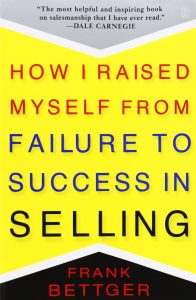Frank Bettger started low and worked himself up. In this book, he offers mentorship, advice and encouragement to people who are either new to sales or want to improve.
Bettger divided his book into six parts, each containing several chapters. In 35 chapters he offers stories and illustrations of how his suggestions worked out in real life and what happened when he didn’t follow them. He writes in an engaging way and many people will like the story telling aspect. The principles are summarized at the end of each part.
His suggestions are very sensible and simple, but not always easy. Most importantly, he advocates a selling style that emphasizes integrity, honesty and sincerity. In part 1 he explains the importance of developing real enthusiasm. He advocates getting organized, keeping records of your sales encounters for later review, the practice of public speaking and planning ahead.
Part 2 introduces the principle that people will only buy what they want. That means the salesman needs to find out what it is that they want. This is done through listening and intelligent asking of questions. He shows how often times people don’t reveal their key objections right away. A simple question whether there’s anything else they are concerned about can often times clear the air and allow the salesperson to give an answer. He also talks about the art of grabing someone’s attention either through an unexpected statement, question or demonstration. Ultimately, a salesman needs to see himself as a problems hunter and solver. To find the problem, he needs to be attentive to the customer’s needs, listen and ask good questions.
Part 3 is all about winning and keeping the confidence of others. The key point here is that confidence is earned through consistent honesty. Don’t exaggerate advantages, don’t ommit problems. People value and trust and confide in honest people. Another aspect that increases confidence is product knowledge. The more you know about your product and how it can be applied in specific areas, the more confident you will be in yourself and the more trust other people will give you. Praise for good competitors, testimonials and a clean, orderly physical appearance are other components that increase confidence.
In part 4 Bettger goes into the psychology of being liked. Honest appreciation of others, focus away from yourself and instead on your customer, avoidance of long winded talks and cultivating a happy demeanor are all important aspects of becoming a person that is liked. Once again, it’s all about integrity, friendliness and a genuine desire to help other people.
Part 5 describes strategies for different steps in the sales process from making appointments to closing. One of the most important insights for me was the approach to first sell the appointment itself. The customer needs to be shown the need to make an appointment and meet with you. Instead of delivering a sales-talk then and there, the customer needs to be eased into wanting to speak to you without giving too much detail. Instead of making them feel like you want them to spend money, show them how you can help them with a problem. Be respectful of their time and don’t be pushy. The second last chapter of this part goes into a 7 step formula to structure the closing process. He uses the AIDA model (attention, interest, desire, action), but calls the last point closing. Closing should be reserved until the very end, until after everything else has been clarified. Here’s his outline:
1. AIDA attention, interest, desire, action (close). don’t try to close before the end
2. summarize advantages of the product, possibly get customer to write it down
3. ask: “How do you like it?”, ask this also during the presentation
4. welcome objections. objections usually indicate interest. show them how to overcome the objections
5. ask “why” if someone doesn’t want to buy, follow up with “in addition to that…any other reasons?”
6. mark an x next to where the signature goes and ask for the signature
7. ask for payment
Bettger recommends to examine each sales appointment afterwards. Only if you go through what you’d like to have done differently and what you think you did well, will you be able to improve.
Part 6 consists of only two chapters and gives delivers two key messages:
- Trust in the law of averages. Sooner or later you will sell something, if you just keep seeing customers. Do not get discouraged by frequent rejection.
- Imitate Benjamin Franklin’s approach to self improvement. Resolve to work on one aspect of your job for one week. List 13 aspects and go through them week by week. If you keep repeating this, you will have worked on each of those aspects for four weeks. Don’t try to do several things at once, but try to improve only one thing at a time.
I like the idea of leaving the reader with some encouragement and advice on how to process all this information. The book is 190 pages long and many different topics are addressed. It can only be mastered one step at a time.
